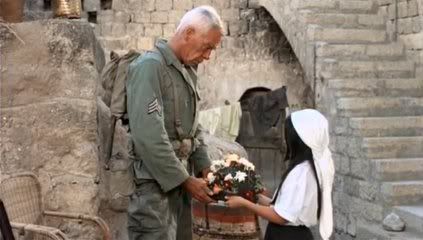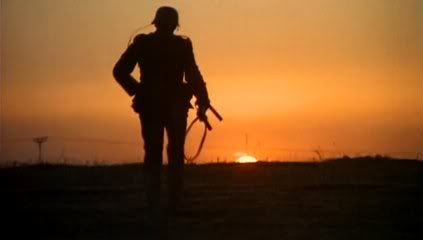Surviving is the only glory in war, if you know what I mean.


After a weekend spent practically gorging myself on movies, I decided to spend my Memorial Day with just one. It's a long one, though -- in fact, some might call it a big, red one on account of all the blood shed over the course of its running time. Or perhaps they would call it that because that's its title. Okay, enough of the cutesy stuff. Samuel Fuller would probably smack me around if he knew I was introducing his magnum opus in this fashion, so let's get down to brass tacks, shall we?.
The Big Red One was the first Samuel Fuller film I ever saw, thanks to its frequent appearances on cable and the four star write-up it got in the TV book. It's an exciting account of Fuller's time with the United States Army's 1st Infantry Division during World War II, which he expanded upon in his posthumous autobiography, A Third Face : My Tale of Writing, Fighting and Filmmaking, but the film as released in 1980 didn't tell the whole story because it was heavily cut by the studio. Thankfully, in 2004 film historian Richard Schickel was able to reconstruct Fuller's original vision based on the shooting script, and that is the version that I sat down to watch today. Boy, am I glad I did.
What was once a gritty, if episodic, depiction of war from the grunt's point of view is now a full-blown masterpiece that brings home how terrifying -- and necessary -- it can sometimes be. It also deepens what was already Lee Marvin's greatest performance as the sergeant who leads his "four horsemen" -- Mark Hamill, Robert Carradine, Bobby Di Cicco and Kelly Ward -- from North Africa to Sicily to Omaha Beach and beyond. Along the way their ranks are swelled by replacement troops, but they quickly learn not to find out too much about these "wet noses" since it's doubtful that they'll still be around for the next campaign. Fuller also tells the parallel story of a German officer (Siegfried Rauch) who matches them step by step and likewise has a way of surviving skirmish after skirmish.
Apart from Marvin, the characters who get the most development are Hamill's sharpshooter, who lacks the nerve to murder until he comes face to face with the ultimate in Nazi atrocities, and Carradine's cigar-chomping writer (and Fuller stand-in). Fuller himself even shows up as a war correspondent shooting some newsreel footage in one of the sequences restored for this edition, and his wife Christa Lang plays an opportunistic German countess. He saves the most powerful sequences for the end of the film, though, when the squad helps liberate a Czechoslovakian concentration camp and Marvin has a heartbreaking encounter with an emaciated little boy. I'm getting teary-eyed again just thinking about it. That's a testament to the strength of Fuller's film. Thirty years on, it still has the capacity to reach both the heart and mind.